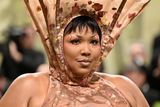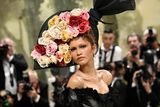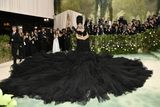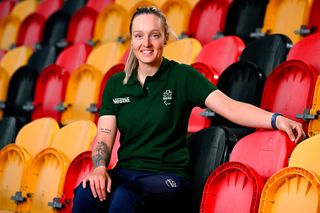Ray of light: Fever Ray
Fever Ray aka Karin Dreijer Andersson - may not much like touring, but her shows are unlike any other you're likely to see.
Even the most seasoned gig goer is unlikely to have seen anything quite like this. The venue -- London's Forum -- is almost entirely bathed in dry ice and powerful lasers shoot green beams to the ceiling. The dimly lit stage is occupied by a group of musicians who wear ghoulish masks and outfits, while one of them, a figure garbed in a troll-like get-up, face obscured, delivers indiscernible noises into a microphone.
Welcome to the world of Fever Ray -- the nom de plume of Karin Dreijer Andersson, the Swedish electro-pop experimentalist who, along with her brother Olaf, has made dark, twisted electronica as The Knife. This year, she stepped out on her own with a debut album -- also called Fever Ray -- that already sounds like a classic. For discerning music fans this could be considered the soundtrack of 2009.
And after the strangeness of her live show has abated, the music hits its mark. For someone who abhorred touring for years -- and refused to play her music live -- Dreijer Andersson seems to have mastered the art. This is a show that will live in the memory for a long time.
Back-track a few hours and Dreijer Andersson is granting Day & Night an audience in her cramped dressing room. For someone who has arrived to the Kentish Town venue much later than normal due to a ferry delay, she is in surprisingly upbeat mood. And, it seems her reputation as a prickly interviewee is misplaced.
Maybe it's because tonight's show is set to be the last in a long time. "It's true," she says in flawless, if heavily accented English. "I don't know when the next Fever Ray show will be. I think there will be another concert some time, but only if there is a new Fever Ray album and I don't know when I will get around to that."
In an interview with a British newspaper some weeks before, she had suggested that she would retire the Fever Ray alter ego, but she sees to have rowed back from that stance. Yet, her antipathy to touring shows little sign of abating.
"I don't like it, especially because I have young children and I don't like being away from them. My favourite place is the studio and I'm looking forward to going back there. I feel most comfortable there.
"When I decided to tour this album, I thought it should only be done if the live experience was different to most other concerts. I wanted it to be very theatrical and to use costumes inspired by Swedish folk tales, and to use make-up in a very different, creative way."
Later in the set, when she dispenses with her troll costume, she cuts an especially sombre character, sporting long hair extensions and a chalk white face, streaked with black lines. Now, though, this tall 34-year-old looks decidedly ordinary in her regular clothes and tied-back blonde hair.
"I like playing with imagery," she says. "I cannot understand why more musicians don't do it as well. I think it's boring to go on stage dressed like you would on the street. Olaf and I tried different images in The Knife and we had fun with it, so it made sense for me to continue with the mischief. It would be funny to send out someone else in my costume and the audience would not be able to tell the difference."
Dreijer Andersson enjoys playing with her audience. In 2007, when The Knife's third album, Silent Shout, won several Swedish Grammies, she and her brother didn't bother turning up to collect their awards. Instead, they sent the organisers a series of weird videos with their faces pixelated and their voices electronically manipulated. "We thought it was funny, but I think some people thought it was disrespectful, arrogant."
Growing up in a small town near Gothenburg may have helped imbue her music with an outsider quality. "There was nothing to do growing up except go to your bedroom and listen to music and read and fantasise. Nothing happened -- it was a very boring place."
With her husband and children, she lives in Stockholm now, but it's unlikely the country's tourist body will be calling on her to do ambassadorial work any time soon. "In many respects, Swedish society can be quite dull and conservative and that is reflected in what music they listen to," she volunteers. "There is some creativity, but a lot of bland music too. But that's what people want to hear."
Despite this, she believes Sweden's ability to punch above its weight on the music front is down to the fact that the education syllabus places a strong emphasis on the arts. "A lot of people learn to play music in school -- possibly more than in most countries and many of them go on to form bands and have some success."
Her first foray into the music world was inauspicious -- she fronted an indie pop band, Honey Is Cool, that seemed to be in the same ballpark as The Cardigans, only not nearly as good. "It was conventional music," she offers. "Everybody has to start somewhere -- I liked playing the guitar."
It was only when she and Olaf started making electronic music together that her talent really shone through. The Knife's eponymous debut was a minor hit in Sweden, but it would be its pulsating follow-up, Deep Cuts, that made a significant impression further afield. The band's fame would increase somewhat when compatriot Jose Gonzales enjoyed success with his version of Heartbeats. Anybody who hasn't heard The Knife's sensational original is urged to check it out.
The next album, Silent Shout, would enjoy even greater acclaim -- the influential website, Pitchfork, chose it as best album of 2007. "It did have an impact because it really rose our profile in the United States, but neither Olaf nor I were interested in touring it to death."
With her sibling's subsequent move to Berlin, Dreijer Andersson took the opportunity to work on her own material and so Fever Ray was born. "Olaf and I had worked together for seven intense years so it was good to work at a different pace."
From a musician whose work is often described as haunting, brooding and difficult, there's a palpable sense of humanity in the album. It offers an emotional journey from start to finish and in such a respect offers the finger to download culture. "I am an old-fashioned person," she says, smiling. "I like albums, not individual songs."
The album is full of songs celebrating childhood. "I started working on it shortly after I had my second child. Being a mother makes you think about being a child yourself and that's there in some of the songs on this album [especially When I Grow Up and Seven]."
She says her daughters enjoy her music, especially the visual part. "They have grown up with it, so it is not unusual for them. Like any parent who loves music, I want them to hear good stuff, not the reality show music you get on Swedish television. But, of course, they will have to make up their own minds. Maybe they will like that stuff."
I suggest that they may in fact develop a love for Katy Perry's music and she grimaces with mock horror. "Anything is possible," she deadpans.
Before Katy Perry has a chance to corrupt them, however, her children are likely to be hearing a lot of her latest project -- an opera based on Charles Darwin that she wrote with Olaf and that's currently playing in Copenhagen.
"I find Darwin to be very interesting, but I don't know much about opera. I don't know whether that's a good or bad thing, but I guess it will make it different to other operas. And, you know, it's nice to be different."
Join the Irish Independent WhatsApp channel
Stay up to date with all the latest news














